Abstract
Nowadays education tends to take into consideration student's personality, his/her individual features and interests. Professors and teachers should elaborate individual ways to develop each student. That is why the most valuable part of educational process is the technologies which take into consideration individual features and abilities of students. This article is focused on experimental approbation of one part of integrative and differentiated educational approach - style technology. The authors determine methods distinguishing cognitive styles of thinking, which have approximately the same result. They show the examples of reformulating the problems adapted to the cognitive ways of thinking. The findings show that the successful figure out of a problem depends on the way the problem was formulated for the students. The problems which are adapted to a cognitive style of thinking of each student are figured out more successfully. The results of the tests confirm that the successful figure out of physics problems depends on cognitive styles of thinking of the students since people with different cognitive styles perceive the text of a task in different ways.
Keywords: Cognitive style of thinkingcognitive style diagnosiscognitive style problem differentiationsuccessful figure out of a problemteaching to figure out problems
Introduction
Federal Educational Standard (Russia) requires physics teachers to organize educational process on the basis of systemic and activity approach. One of the ideas of this approach is to include every student into the educational process. It is necessary to take into consideration individual features of each student to implement systemic and activity approach since the object of educational process becomes its subject when the problem stated by a teacher is accepted to think over. Professors and school teachers are required to elaborate individual ways to develop each student. That is why the most important part of educational process elaboration becomes the technologies focused on individual features and abilities of students: differentiated (Drobysheva, Drobyshev, Nikanorkina, & Kuzina, 2016) and individual (Mukhina, 2015) ways to teach, integrative differentiated way (Degtyarev, 2015; Stikhova, 2008; Stikhova, 2014; Surovtsev, Barkalov, & Belousov, 2006) and others.
Problem Statement
One of the activities which is obligatory to be mastered at school is to figure out problems. The observations of students figuring out problems show that one and the same problem is easy for some students and difficult for others, and some students figure out quantitative problems more successfully while others are better in figuring out qualititativeones. One of the reasons why students do not accept a problem stated by a teacher or printed in a student's book is that they do not understand the text of a problem. Some authors believe that successful figuring out of a problem depends of cognitive condition (Isakova & Yusupov, 2017), others think that students may not understand the problem because their perception of problem text depends of their cognitive way of thinking (Gidlevskii, 2010).
Cognitive style of thinking is one of the basic concepts in psychology. Achievements in cognitive thinking researches were integrated into pedagogy to create better conditions for cognitive activity of students. The idea to implement psychology findings about cognitive styles into educational process is now new:
level-style differentiation within modular education (Danushenkov & Korshunova, 2011);
level-style differentiation within integrative differentiated approach to organize specialized education (Danushenkov & Korshunova, 2005);
level-style differentiation within professional training of teachers of rural schools (Korshunova, 2010);
development of critical thinking of future specialists (Anisimov, 2010);
formation of cognitive styles and strategies within individualization of the way to teaching (Mukhina, 2015);
influence of thinking fluency on figuring out of mnemonic problems successfully (Fedoseeva, 2011);
connection between individual style of information processing and comprehension of a problem text (Gilev, 2006).
However, the researches about the connection between the successful figure out of physics problems by the students and their cognitive styles have not been led in educational organizations of general and upper secondary education yet.
Research Questions
The classification of cognitive styles is rather broad. Russian and foreign psychological and pedagogical literature observes about twenty cognitive styles. M.A. Kholodnaia distinguishes 10 general cognitive styles in her book “O prirode individealnogo uma”: field dependency/ field independency, narrow/wide range of equivalence; rigid/ flexible cognitive control; narrow/ wide category; focusing/scanning control; leveling/ sharpening; tolerance/intolerance to unrealistic experience; impulsivity/ reflexion; concrete/ abstract conceptualization; cognitive simplicity/ complexity (Kholodnaia, 2004).
Berulava and Berulava (2010), basing on researches about the way people percept the world around them (as a whole or a set of different objects), distinguishes two cognitive styles of thinking: integral and differential. The author says that this broad classification does not show all of integral features of cognitive thinking, hence it is necessary to distinguish elements of each style: emotional, theoretical and active:
integrally theoretical;
integrally emotional;
integrally active;
differentially theoretical;
differentially emotional;
differentially active.
People who have integral style of thinking are inclined to percept a studied object as a whole, those who have differential style - are inclined to perceive reality as a set of elements.
Integrally theoretical style is referred to cases when the understanding of a situation may be formulated in one concept and the situation is perceived as a static one.
Integrally emotional style may be diagnosed if the generalized assessment of a situation is emotional.
Integrally active style is formed if a situation is perceived in motion and may be formulated in one concept.
Differentially theoretical style may be diagnosed if a person perceives a static situation as a set of elements.
Differentially emotional style may be diagnosed if the emotional concepts appear.
Differentially active style is formed if the situation is perceived in motion and as a set of elements.
Purpose of the Study
The hypothesis of the study: students will master the activity to figure out problems more successfully,
Research Methods
The research on the connection between successful figure out of physics problems and cognitive styles of thinking was led in secondary school №126, Ufa. Natalia Vladimirovna Kosareva, physics teacher of the highest category managed the experiment with 29 students of the 9th grade participating.
Cognitive styles were studied with two methods: 1) students were asked which form of cognitive study they prefer (Korshunova, 2010) and 2) they were asked to describe images (Sirotyuk, 2004).
The connection between cognitive style of thinking and the successful figure out of physics problems was studied in three steps.
At the beginning of the research, students did the test about "Optics" which was not differentiated in cognitive styles (figure
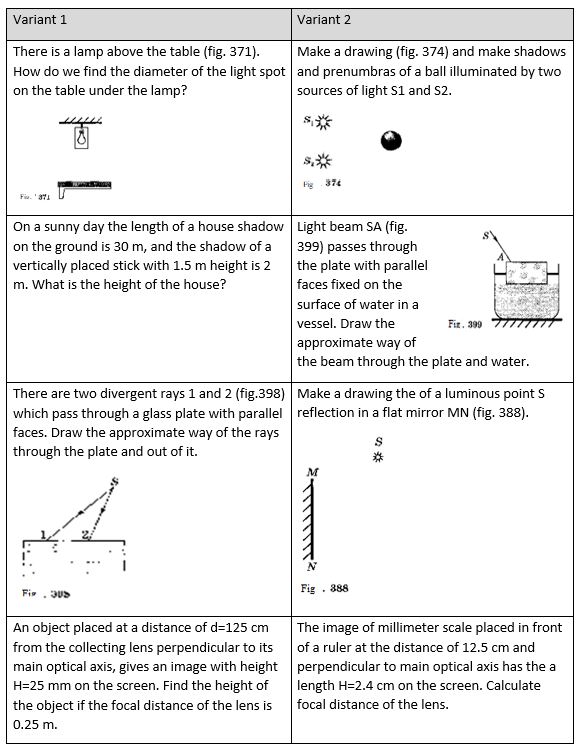
After the results of the test were analyzed, the tasks were re-formulated according to the cognitive styles of the students. As it was mentioned before, the main feature of the integrative styles is that the situation is perceived as a whole. It is better to teach students with this cognitive style, firstly, abstract concepts and then concrete, firstly general then its parts. It is necessary to describe a law of physics before studying forms of its manifestation.
It is necessary to take into account the special features of the integral cognitive styles mentioned above when formulating the tasks: you should formulate the question first, then give the conditions/ initial data. This way the necessity of move from abstract to concrete is taken into account: the questions about general phenomena and processes are asked in the problem, then they are specified by input data.
Main feature of differential styles is that the situation is perceived as a set of elements. It is necessary to organize study of the material from concrete to abstract; from parts to the whole object. Studying the law of physics it is necessary to focus on some particular moments of its manifestation and then to study the law itself.
In accordance with the specific features of differential styles, when formulating tasks, it is necessary to follow the rule: to give initial data firstly and then state the question. In this case a teacher follows the tendency to go from parts of an object (initial data) to the whole object (the question about a phenomena or a process in a task).
According to the stated rule, we made a test differentiated in cognitive styles (figure
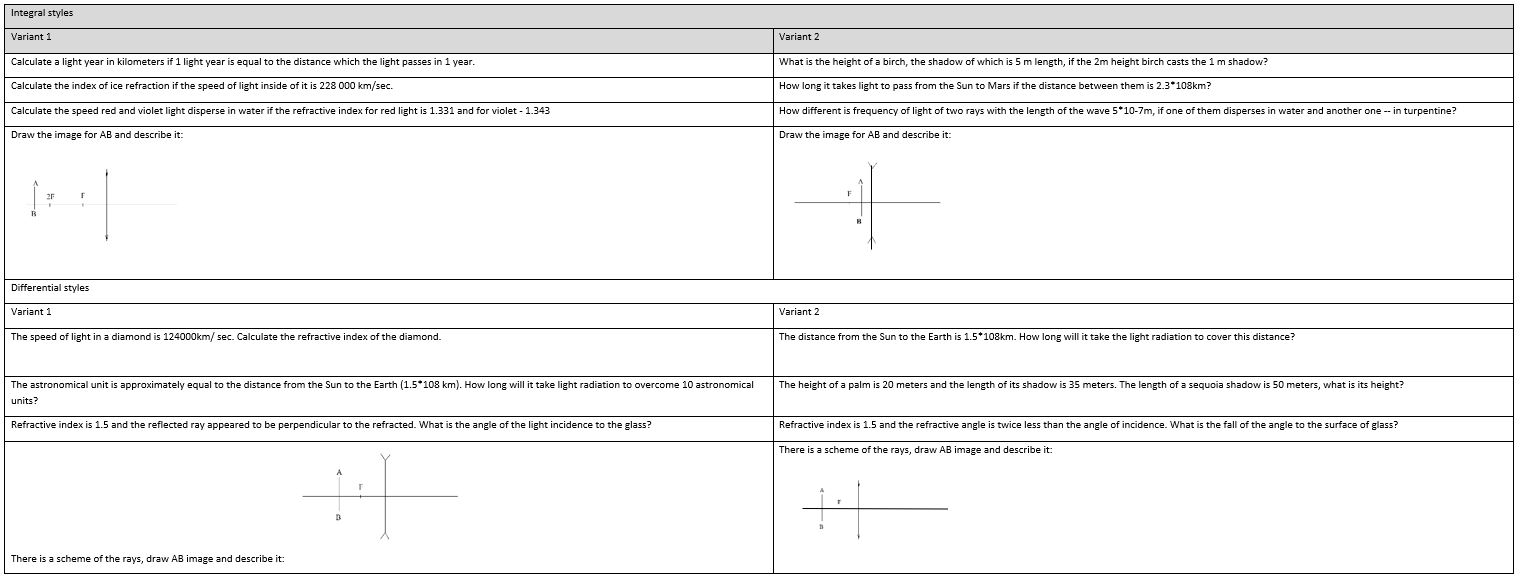
It was decided to confirm the dynamics caused by use of tests adapted to cognitive styles of thinking by making the third test to check "Physics of atomic nucleus" module. It was reasonable to test this module because the material was not refreshed before the test as it was done with optics test. That means that the results should be more reliable (table
Findings
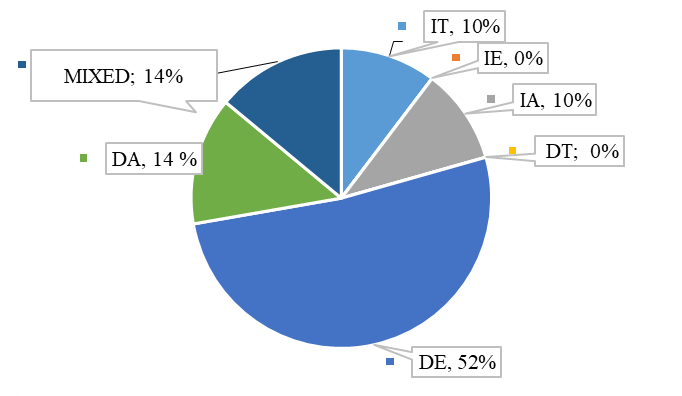
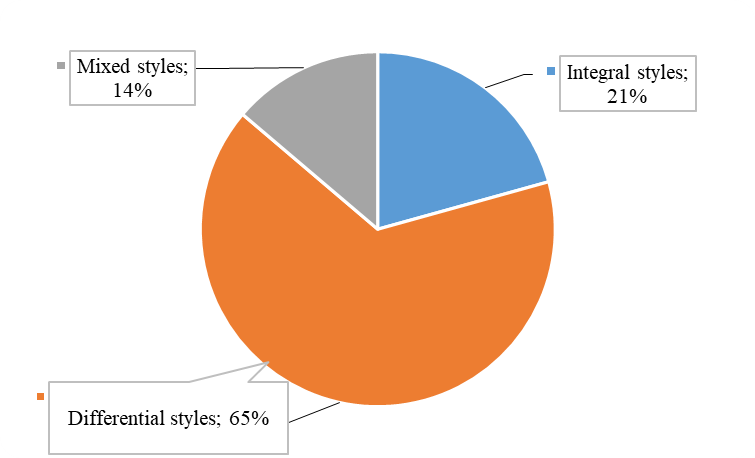
Both methods (Korshunova, 2010; Sirotyuk, 2004) showed a similar distribution in cognitive styles (figure
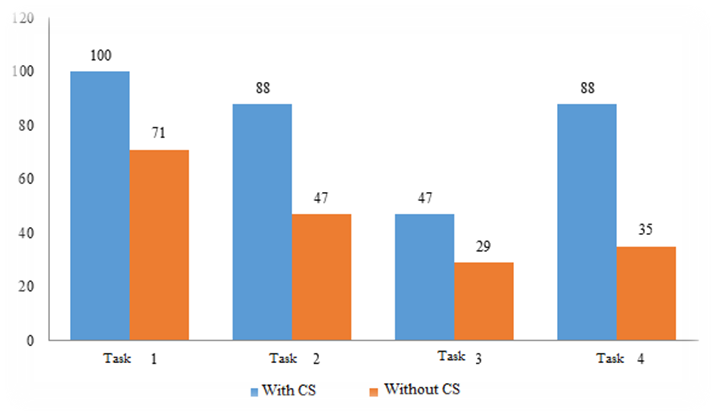
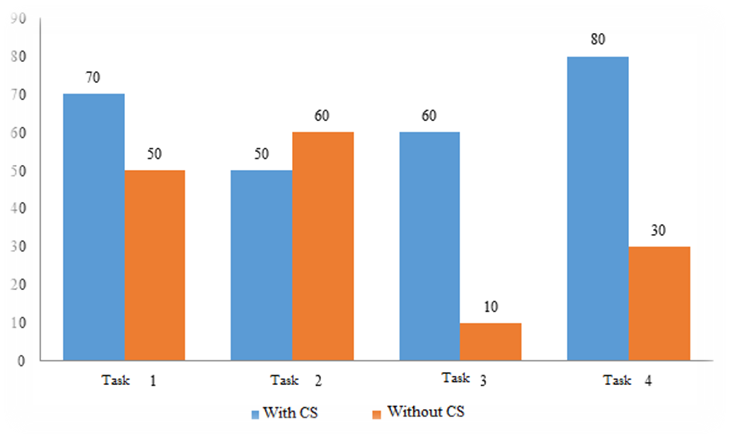
Results of the optics test, which was not adapted to cognitive styles of thinking showed the following: academic performance – 55%, quality of education is 22% (figure
Results of the optics test, which was adapted to cognitive styles of thinking showed the following: academic performance reached 96.2%, education quality index was 60% (figure
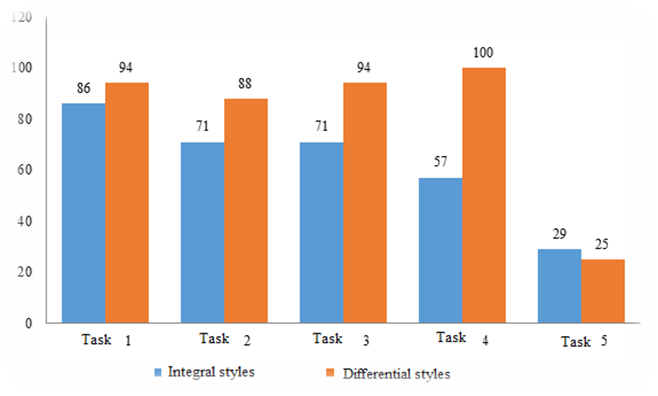
Results of the physics of an atomic nucleus test, which wasadapted to cognitive styles of thinking, showed the following: academic performance 92%, education quality index -- 58.3% (figure
Conclusion
The results of the tests confirm that the successful figure out of physics problems depends on cognitive styles of thinking of the students since people with different cognitive styles perceive the text of a task in different ways, however, some results are subject to specification:
Task №2 in the second optics test was more difficult for students with integral styles than a similar task before it was adapted in accordance with cognitive styles. Probably, it happened because the text was re-formulated for students inappropriately, what is also subject to confirmation.
Task №5 of the third "physics of an atomic nucleus" test appeared to be very difficult for all thinking styles students: it was done only by 29% of students with integral style and by 25% of students with differential style. These low results, most likely, show that the task was highly complicated, however, it also is subject to confirmation.
Generally, the tasks adapted to different cognitive styles of thinking positively influence students' academic performance as they master to figure out physics problems easier.
References
- Anisimov, O. S. (2010). Razvitie kriticheskogo myshleniya u budushchego specialist [The development of critical thinking in the future specialist]. Acmeology, 4, 33-37.
- Berulava, G. A., & Berulava, M. M. (2010). Stereotipy psikhicheskoj aktivnosti lichnosti [The stereotypes of mental activity]. Humanisation of the education, 8, 15-28.
- Danushenkov, V. S., & Korshunova, O. B. (2005). Integrativno-differencirovannyj podkhod v organizacii profil'nogo obucheniya v sel'skoj shkole [Integrative differentiated way to organize specialized teaching in a rural school]. Profile school, 2, 15-24.
- Danushenkov, V. S., & Korshunova, O. B. (2011). Tekhnologiya urovnevo-stilevoj differenciacii v ramkakh modul'nogo obucheniya [Level and style differentiation technology within module education]. Pedagogy, 2, 41-46.
- Degtyarev, V. A. (2015). Vuzovskaya praktika: integrativno-differencirovannyj podkhod [University practice: integrative and differentiated approach]. The unity of science: international scientific periodical journal, 1-1, 67-71.
- Drobysheva, I. V., Drobyshev, Y. A., Nikanorkina, N. V., Kuzina, N. V., & Drobysheva, S. Y. (2016) Tekhnologiya differencirovannogo kompetentnostno-orientirovannogo obucheniya studentov matematike [Differentiated competency-based technology to teach students mathematics]. Moscow: Publishing House: OOO "TRP".
- Fedoseeva, O. I. (2011). Osobennosti vliyaniya gibkosti myslitel'nykh dejstvij na uspeshnost' resheniya slozhnykh mnemicheskikh zadach [Fluent mind influences mind activity and successful figure out of mnemonic problems]. Vestnik of Nizhny Novgorod state linguistic university n.a. Dobrolubov, 13, 208-215.
- Gidlevskii, A. V. (2010). Prostoj metod ocenki trudnosti uchebnykh testovykh zadanij [An easy method to assess difficulties in educational test tasks]. Integration of education, 4, 20-24.
- Gilev, A. A. (2006). Kognitivnoe obuchenie fizike v sisteme vysshego tekhnicheskogo obrazovaniya [Cognitive teaching of physics in the system of higher technical education]. Vestnik of samara state technical university. Psychological And Pedagogical Sciences, 47, 20-29.
- Isakova, Y. L., & Yusupov, M. G. (2017). Vliyanie poznavatel'nykh sostoyanij na uspeshnost' resheniya zadach [The influence of cognitive conditions on the success of problem solving Psychology of mental States]. Kazan: Kazan (Volga region) Federal University.
- Kholodnaia, M. A. (2004). Kognitivnye stili. O prirode individual'nogo uma [Cognitive styles. About the nature of individual mind]. Saint Petersburg: Publishing house "Piter".
- Korshunova, O. V. (2010). Sistema professional'noj pogotovki i povysheniya kvalifikacii uchitelej sel'skikh shkol po probleme integrativno-differencirovannogo podkhoda k obucheniyu [The system of professional training and improving qualification of rural school teachers within the problem of integrative-differentiated way to teach]. International experimental education journal, 5, 109-115.
- Mukhina, S. E. (2015). Individualizaciya obucheniya v vysshej shkole cherez formirovanie kognitivnykh stilej i strategij [Individualization of education in higher school forming cognitive styles and strategies]. Vestnik of Moscow University, Pedagogical education, 20(4), 70-80.
- Sirotyuk, A. L. (2004). Differencirovannoe obuchenie mladshikh shkol'nikov s uchetom individual'no-psikhologicheskikh osobennostej (Doctoral dissertation) [Diffirentiated child-friendly teaching methods]. Retrieved from: https://new-disser.ru/_avtoreferats/01003298162.pdf
- Stikhova, A. M. (2008). Integrativno-differencirovannyj podkhod v obuchenii khimii [Integrative differentiated way to teach chemistry]. Science and school, 4, 10-20.
- Stikhova, A. M. (2014). Integrativno-differencirovannyj podkhod k samostoyatel'noj rabote studentov pri obuchenii khimii v vuze [Integrative differentiated approach to independent student work studying chemistry at the university]. Vestnik of Chelyabinsk state pedagogical university, 2, 234-249.
- Surovtsev, I. S., Barkalov, S. A., & Belousov, V. E. (2006). Upravlenie kachestvom obrazovaniya v vuze - integrativno-differencirovannyj podkhod [Education quality management in a University - integrative differentiated approach]. Scientific Newsletter of Voronezh state architecture university, Construction management, 2, 15-19.
Copyright information

This work is licensed under a Creative Commons Attribution-NonCommercial-NoDerivatives 4.0 International License.
About this article
Publication Date
15 November 2020
Article Doi
eBook ISBN
978-1-80296-092-1
Publisher
European Publisher
Volume
93
Print ISBN (optional)
-
Edition Number
1st Edition
Pages
1-1195
Subjects
Teacher, teacher training, teaching skills, teaching techniques, special education, children with special needs, computer-aided learning (CAL)
Cite this article as:
Kosarev, N., Kosareva, N., Fatykhov, M., & Sharifullina, A. (2020). Cognitive Way Of Thinking In Teaching To Figure Out Physics Problems. In I. Murzina (Ed.), Humanistic Practice in Education in a Postmodern Age, vol 93. European Proceedings of Social and Behavioural Sciences (pp. 536-546). European Publisher. https://doi.org/10.15405/epsbs.2020.11.55

